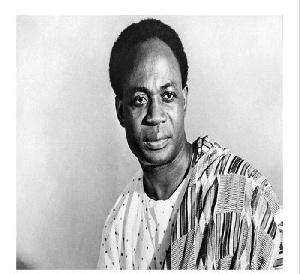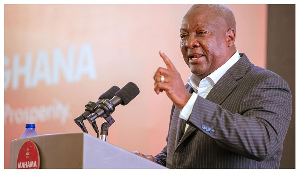By: Prof Lungu
In Celebration of Kwame Nkrumah's Exemplary Performance on Behalf of Unitary Ghana During 1951 - 1966
"...Kwame Nkrumah was overthrown in 1966 just as his government was fine-tuning the 7-Year Development Plan...And, even if all of that $870M was spent on only just these 32 projects and facilities listed below, practically all of which still exist in the service of Ghana more than 51 years later, most Ghanaians ought to be glad for those investments....(for)...helping Ghana produce goods and services of major proportions...Respectfully, there is a difference between employing borrowed capital...for purposes of national investment according to a national development plan, versus using those same resources to construct hotels and cathedrals for private interests, and divvying up to party members, friends and family members factories, houses, automobiles...acquired from those same borrowed resources...", (Prof Lungu, 11 Mar 17).
Any definitive account of the history of Ghana must also take a look at what Ankrah and the Nonentities, Liars, and Crooks (NLC) who overthrew the CPP government of Kwame Nkrumah's said Ghana owned to foreign creditors in 1966, versus what official records say Ghana actually owned to foreign creditors. Our take is, every "young Ghanaian" ought to be know the difference, even if many "elders" have, over generations, obfuscated the truth, or they just have never cared.
Respectfully, this is important in order to teach and learn the difference between employing borrowed capital and other resources for purposes of national investment according to a national development plan, versus using those same resources to construct hotels and cathedrals for private interests and divvying up to party and friends factories, houses, and automobiles, etc., acquired from those same borrowed resources and sources.
In a rather startling piece of commentary just the other day to our "Quantum leap in economy under Kwame Nkrumah, 1951-1966" essay, using "Read" as moniker, an individual posted text of a 14 April 1965 speech in the British House of Commons by Mr. John Cordle (Bournemouth, East and Christchurch). While noting that Kwame Nkrumah may have misjudged certain aspects to the then world economy/who controls what, Mr. Cordle said this about the transition of the Gold Coast into Ghana's, right at the beginning:
"... In 1951 the deficit on current account (of the Gold Coast) was £52 million...".
(Around 1951, £152M (GBP Pound Sterling) was approximately equivalent to $423.3M (USD)).
The graph above shows that the Gold Coast had a trade deficit with the United Kingdom even before that colonial government began to put in place mechanisms for the sovereignty for the Gold Coast.
In 1952, when Kwame Nkrumah had just been released from prison and appointed "Leader of Government Business" with the CPP's "Independence Now" clarion call, the Gold Coast, as a colony, was naturally "trading" with the UK at a £12.4M ($34.6M) trade deficit. Safe to say that the British were not investing in Ghana in 1952 for the benefit of Africans in their colony, except incidental to the production systems they had set up to support the British economy and their industrial cities and towns such as Liverpool, Birmingham, London, etc.
Safe to say that for the "investment perspective", with the government firmly in the hands of Nkrumah's CPP beginning in 1953, every increase in the trade deficit (with the UK, as an example), would be directly related to investment for the benefit of the Africans in the Gold Coast.
As such, it bears mentioning here that the Ashanti Region flagship hospital, the 500-bed Komfo Anokye Teaching Hospital (KATH), otherwise known as GEE, was constructed during 1952-1954 by British firm, GEE. The service area of GEE included the Ashanti Region and places north, west, and east of Kumasi. That hospital cost $10M to construct. That facility would be reflected in one or more years of the deficits shown in the graph above. Same goes for the Port of Tema and harbor. Constructed during 1951-1962, the habor project alone cost $78M. Consulting engineers (Sir William Halcrow and Partners), and primary contractor (Parkinson Howard Limited), were as well, British firms.
In sum, Kwame Nkrumah and his CPP government invested in Ghana using Ghanaian funds and funds borrowed from external sources on account of the severe socio-economic and developmental conditions in colonial Gold Coast and new Ghana.
Kwame Nkrumah and his CPP government always had ambitious multi-year plan as basis for capital expenditures and investments.
In 1966, the highest and most credible estimate of the amount of money Ghana owned foreign entities and governments at the overthrow that we've been able to discern is $870M ( £312M), per the IMF.
However, the account by the Nonentities, Liars and Crooks (NLC) as told by Ankrah said Ghana owned over £400M (as in British 400,000,000 million pound sterling). That would have been the equivalent of $1.1 billion ($1,115,121,779 US dollars).
As reported in Keesings Record of World Events (March 1966):
"...An outline of the N.L.C.'s economic policy was given on March 2 by General Ankrah, who stated that the Nkrumah Government had left Ghana with a national debt of over £400,000,000, as against £20,000,000 at the achievement of independence.
$1.1 billion!
Yes, right!
That was a coup plotter farcical lie!
Even so, if was in fact true that Ghana owned $1.1 billion to foreign interests in 1966, that would still have been less than 50% of Ghana's GDP ($2,126,361,135.24), that same year.
But no, that was a coup plotter farcical lie by the General Nuke-Vietnam-Ankrah of the traitor bunch who called themselves the "NLC".
On the contrary, according to the numbers we've seen, $870M in foreign debt owned as of February 1966 is in fact the most accurate/complete estimate.
And, even if all of that $870M was spent on only just these 32 projects and facilities listed below, practically all of which still exist in the service of Ghana more than 51 years later, most Ghanaians ought to be glad for those investments to the extent they continue to make the lives of Ghanaians better by helping Ghana produce goods and services of major proportions.
Take your pick and add up your own figure for cost and value as of this year, 2026.
Limited List of Kwame Nkrumahs Investments for Ghana:
1. University College of Ghana – Sewer/Drainage
2. Tema Development Corporation – Sewer/Sewage
3. Port of Tema – 4-Berth, Harbor; constructed 1951-1962, opened in 1962
4. Achiasi-Kotoku Railway Line
5. Achiasi-Kotoku Station Buildings (local contractors)
6. Volta Bridge –Steel Arch, 805ft, concrete approach span, 5miles approach roads
7. Tema-Afienya Road – 12 miles
8. Shai-Kpong Road – 19 miles
9. Accra Town Roads 2.1 miles plus Car parks, landscaping
10. Winneba-Mankesim Road
11. Pwalagu & Nasia: 2 Steel Bridges 300ft and 455ft
12. Aniben Bridge
13. Dunkwa-Oboasi Road and Bridge Over Ofin River
14. Univ College-Ghana – New Univ Bldgs
15. Tamale Water Supply and Pumping Station, Main
16. Tamale Water Supply - River Intake/Water Towers/Reservoir
17. Swedru Water Reservoir and Dam
18. Swedru Water – Intake Works, purification Plant, Pumping Station, Water Works
19. Kumasi College of Tech – Water / Booster Station, Water Tower, Distr Main
20. Kumasi College of Technology – Students Halls of Residence
21. Multi-Regional Hospital, Kumasi General Hospital (GEE)
22. Cape Coast University
23. Cape Coast University
24. Kwame Nkrumah University of Science and Technology
25. Accra-Tema Motorway
26. Akosombo dam
27. Black Star Line
29. VALCO
30. GIHOC
31. State Hotels and Catering Rest Houses all over Ghana
32. 24 Railway locomotive purchased by Komla Gbedemah for Swiss firm.
As the IMF reported:
"...By the end of 1965, Ghana had undertaken 222 separate commitments for loans and credits from 22 foreign countries in respect of specific projects involving a total expenditure of some $870 million. Most of the contracts call for repayment in five to eight years. Scheduled capital repayments and interest on suppliers' credits in 1966 represent about 23 per cent of exports expected during this year...".
Clearly, not even Ghanaians can have their cakes and still eat them, too!
In conclusion, Kwame Nkrumah was overthrown in 1966 just as his government was fine-tuning the 7-Year Development Plan, about the 3rd of such a plan beginning in 1952. Respectfully, there is a difference between employing borrowed capital and other resources for purposes of national investment according to a national development plan, versus using those same resources to construct hotels and cathedrals for private interests, and divvying up to party members, friends, and family members, factories, houses, automobiles, etc., acquired from those same borrowed resources.
So it goes, Ghana!
SOURCES/NOTES
1. Prof Lungu, Quantum leap in education under Kwame Nkrumah and the CPP (1951 - 1966), http://www.ghanaweb.com/GhanaHomePage/features/Quantum-Leap-in-Economy-Under-Kwame-Nkrumah-1951-1966-516095
2. Prof Lungu, Quantum leap in education under Kwame Nkrumah and the CPP (1951 - 1966), http://www.ghanaweb.com/GhanaHomePage/NewsArchive/Quantum-Leap-in-Education-Under-Kwame-Nkrumah-and-the-CPP-1951-1966-514207.
3. Stanford.edu. Initial Measures. Keesing's Record of World Events, Volume 12, March, 1966 Ghana, Page 21273).
4. KATH/Gee Hospital Still Is Another Kwame Nkrumah Sika Duro (Final)
http://www.ghanahero.com/Visions/Nkrumah_Legacy_Project/Prof_Lungu/KATH_Gee_Hospital_Still_Another_Nkrumah_Sika_Duro_Final.pdf
Visit for more information:
www.GhanaHero.com.
Read Mo'! Listen Mo'! See Mo'! Reflect Mo'!
Prof Lungu - Real Data, Real Current!
Subj: Quantum Leap in Economy Under Kwame Nkrumah, 1951-1966 (Part 2).
Twitter: https://twitter.com/professorlungu
Support Fair-Trade Oil Share Ghana Campaign/Petition
https://www.change.org/p/ghana-fair-trade-oil-share-psa-campaign-ftos-gh-psa/
Brought to you courtesy www.GhanaHero.com©12 Mar 17.
Opinions of Monday, 13 March 2017
Columnist: Lungu, Prof.



















